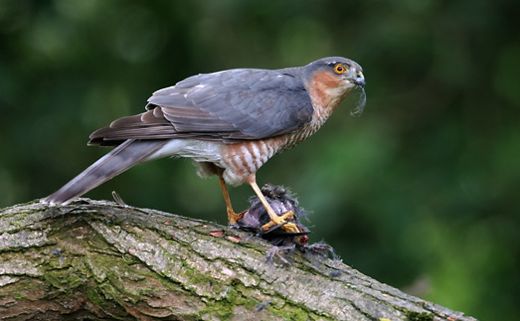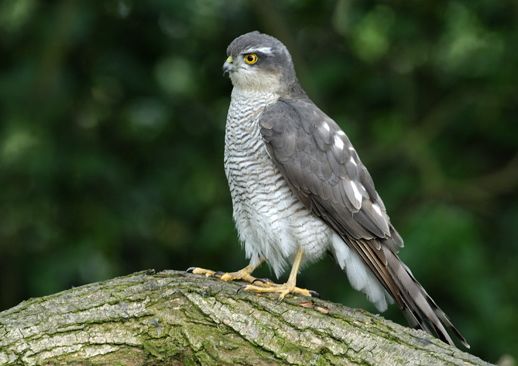The Eurasian Sparrowhawk (Accipiter nisus) is a forest and open woodland species. Although Thiollay (1994) reported it to be not usually found in urban gardens and parks, Hume (2002) says that it is “bold enough to hunt in gardens and parks.”
The bird is found throughout Europe, except Iceland. During the 1950s and 1960s populations decreased significantly through accidental pesticide poisoning. However, since the 1970s, numbers have increased as a result of enlightened attitudes, protection and controlled use of pesticides.
It builds a simple platform of twigs on flat branches close to the trunk and lays 4-5 eggs. It raises only one brood a year, around March-June. It feeds almost exclusively on small and medium-sized birds like tits, finches, thrushes and pigeons. The image above shows an adult male with prey in a garden in Cheshire, England.
According to Dave, the “male chooses the nest site at the end of February, builds a platform of nest, then the female helps 7/10 days later (below). They come every morning spending approximate one hour, then back around 1130 hours.
“Every time they meet they do courtship ritual, and early May courtship could be up to 12 times a day especially when male brings in a kill. She takes it off him, he goes to check the nest then comes back to mate without fail. Then they sit side by side, preening.
“As soon as 5 eggs are laid she doesn’t like him to come close but she has let him come closer than last year. When he visits her on nest, she is more tolerant. When she is ready to lay an egg, she totally ignores him. If he brings a kill, she will allow him to approach or she will come to him, take the prey and hide it in the ivy in the willow tree and have it later.
“I have put small pond under the chopping block and she used it instantly to drink, hope she bathes in it as I have a cam on it.
Check out Dave’s webpage HERE and a footage of the sparrowhawk nesting in his garden HERE.
Dave Culley
Singapore
June 2008
References:
1. Hume, Rob (2002). Birds of Britain and Europe. London: Dorling & Kindersley.
2. Thiollay, J. M. (1994). Family Accipitridae (Hawks and Eagles). Pp. 52-205 in del Hoyo, J., Elliott, A. & Sargatal, J. eds. Handbook of the birds of the world. Vol. 2. New world vultures to guineafowl. Barcelona: Lynx Editions.
Images by Steve Magennis; and Chris Sperring MBE provided various assistance.










